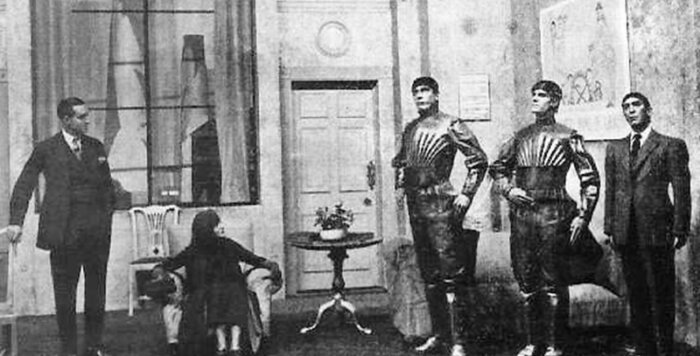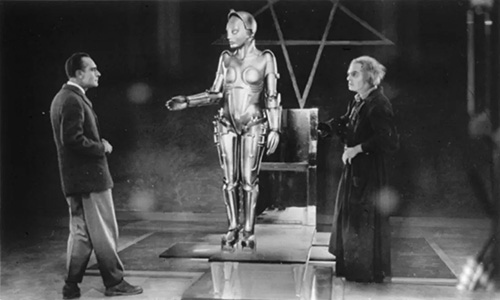
The origin of the word Robot, is the Czech word robota, meaning “forced labour”, from a Slavic root – rab, meaning “slave”. Herein lies much of our fear and angst when we consider the future of robots because Slave implies a Master and so slaves are capable of revolt – of turning against their masters…
The pursuit of developing robots, is that they might assist humans in doing jobs which are too difficult, dangerous or just too plain boring for humans – things which in the past, and even today – (think wage-slaves, modern slavery) – have been done by human slaves and so these fears have a foundation in fact – there have been many slave revolts!

The problem of creating robots is twofold – body, and mind. On the body side, we have long had Automatons – they range from say a music box which can play a tune, to the most sophisticated machines that are now being tested for their ability to play football. On the mind side, we have the quest for AI – Artificial Intelligence which is the subject of hot debate at present for reasons varying from “Will AI take our jobs away?” to “Will AI outgrow and destroy human beings?” which brings us back to the man who first coined the word robot in his play “R.U.R.” (which stands for “Rossum’s Universal Robots”) premiered in Prague in 1921, Karel Čapek. Like many of his generation, just out of the horrors of the First World War, Čapek was sceptical of the utopian benefits of science and technology – or rather the uses which human beings put those things. You can read a more detailed account of his play here. But what “R.U.R.” illustrates is that science fiction is the way we explore the possibilities and problems of what may be achieved in the development of robots and our relationship to them.
Starting with the body problem, long before the amazingly intricate creations of the 18th century with watchmaker ingenuity inside, the ancient Egyptians imbued statues with souls and the Greeks envisaged artificial men such as Talos But those later amazing mechanical figures who might play a tune on an inbuilt musical box, are only built to perform one task, albeit a potentially complex task and in this respect, modern technology has created many robots which assist us today without posing any threat except to the workers they superseded. Car plants use many robot arms to manufacture cars with greater strength, dexterity (programmed), speed and accuracy than the human beings who used to do the jobs. Still, without reprogramming, these robot arms do one thing only and their “intelligence” is limited to a programmable computer.

Turning to the issue of robotic minds – Artificial Intelligence is progressing in leaps and bounds, to use an anthropocentric metaphor – several people doing this year’s A to Z Challenge have experimented with AI including Misky who has used the AI graphic app Midjourney to create amazing illustrations for the poems she has posted – check out her site! She has talked about how many times she has to try and prompt the app in order to get these illustrations the way she wants them, tweaking the style and content descriptors and this shows that although the Midjourney app is incredibly powerful, it is still soft AI. The limitations of soft AI are best illustrated by Alexa the Amazon speaker app – instruct it thus “Alexa – tell me a joke!” and she will indeed tell you a joke, but then say “Alexa – tell me another…” and Alexa doesn’t know what you mean unless you specify “another joke”. Hard AI would be the kind which was truly capable of independently sentient thought, and we are some way off from that if Alexa is anything to go by. Alan Turing, imagining (stupendously) the future possibilities of AI devised the Turing Test in which an evaluator would hold two remote conversations, with a human being and with an AI and if they could not distinguish which was the AI, then it might be said to have truly intelligent behaviour. We may be approaching this watershed moment but I like to think that, writing this blog, for example, an AI would not be drawing out the ideas that I have – at least not without close supervision – anyway, I am going to do my own evaluative exploration of AI right here once the A to Z is finished, so watch this space…
The problem for designing robots which are indistinguishable from human beings, is how to cram an AI sizes computer into the body of a robot – Chat GPT can generate text which only another special app can discern to have been written by an AI, but the computers necessary to run ChatGPT are enormous and the miracle which is the human brain is most notable for its compact size – given it’s power. Nevertheless, there are many who are afraid that AI alone, without human-looking robots, can outmatch the human race and destroy it. Of course, we have many science fiction thought experiments to thank for that particular trope from Čapek’s “R.U.R.”, Fritz Lang’s “Metropolis”, through Asimov’s “I Robot”, My own favourite, “Bladerunner” and looming large in these debates about the dangers of rampant AI – the “Terminator” series of films.

In all these fictional considerations of the relationship between men and machines, different solutions are proposed to keeping the “robota -slaves” in check. Asimov came up with The Three Laws of Robotics –
- First Law: A robot may not injure a human being, or, through inaction, allow a human being to come to harm.
- Second Law: A robot must obey orders given it by human beings, except where such orders would conflict with the First Law.
- Third Law: A robot must protect its own existence as long as such protection does not conflict with the First or Second Law.
These laws would be encoded into the AI controlling all robots at their inception and would be sacrosanct. This idea escaped the creators of the Terminator series robots whilst in Bladerunner, the manufacturers of the “replicants” had to build in auto-destruction of their products after a small number of years lest their self-learning robots get too big for their boots and turn on their creators – sensibly too, replicants were not allowed on Earth but only sent to do the typical jobs of slaves, out in space as miners, soldiers, builders – dirty, dangerous jobs. Ultimately, the Replicants in Philip K. Dick’s story, show us something about what it is to be human ( as all good science fiction does, if only because it is written by humans), at the end of the story, (spoiler alert) the human Bladerunner, charged with tracking down and destroying renegade Replicants who have made it to Earth in pursuit of getting their lifespans extended, is being dangled over the edge of a roof by the leader of the group of Replicants. Rutger Hauer, the actor who plays The Replicant Roy Batty, whilst dangling the Bladerunner, makes a speech which has become known as the ”Tears in the Rain monologue” as follows:
“I’ve seen things… seen things you little people wouldn’t believe. Attack ships on fire off the shoulder of Orion bright as magnesium… I rode on the back decks of a blinker and watched C-beams glitter in the dark near the Tannhäuser Gate. All those moments… they’ll be gone.”
Moments later he lifts the Bladerunner to safety just before his brain self-destructs – talk about saved by the bell! But of course, the Bladerunner -played by Harrison Ford, was saved by the robot/ replicant, perhaps out of mercy (a very human trait which the replicant might have developed) but perhaps in the hope that the Bladerunner might respond by trying to change things for Replicant To me this gets to the crux of being human – just when we are getting the hang of life, out time is up…
Incidentally, Rutger Hauer, not liking the lines that had been written for him, and with only a few minutes of shooting time left, famously improvised the “Tears in the Rain” monologue – kudos!
In our fears over the development of robots and AI, are we perhaps projecting our fears about our own human traits onto them, we aspired to create them to be our helpers, such as AI interpreting MRI scans more effectively than human beings, so why would we think that AI would want to destroy or enslave human beings (The Matrix)? Perhaps it’s because we human beings, given the chance, have all too often enslaved other human beings, abused, exploited and been ready to lynch them at the first sign of independence, let alone revolt. Do we need to take heed of the results of science fiction’s thought experiment warnings – of course we do! We should no more allow the unregulated development of AI any more than we would allow our children to play with loaded guns, but those regulations would be to keep in check the humans who would use AI, or rather misuse it. We should watch out for governments who want to create AI-powered weapons or control their people with ever more efficient propaganda – even before AI we are struggling to know what is true in the news. We have plenty to worry about in the humans – let alone AI and Robots. However, between regulation, commonsense, and perhaps most of all. the fact that AI might have learned lessons from the human mistakes that are messing up the planet, might we be pleasantly surprised to find that AIs assist us as they were intended to do, solving problems of the environment, working out how to operate an economy not based on permanent growth and war – might we be headed for Iain Banks’ “Culture” series rather than “Terminator”…
So one final sci-fi thought experiment from the great Marge Piercy – “He, She and It”, which goes to the question of what would happen if we could achieve hard AI and make it small enough to fit into an android-style (human shaped) robot. In an environmentally post-apocalyptic world, a woman is given the task of socialising just such an android, because Marge Piercy imagines that true sentience, as opposed to a glorified search engine, would require teaching and guiding as to what sense to make of the world – rather like a child. If she is right, then the great leap forward to hard AI, true sentience, would not be a runaway Terminator scenario, but a chance to imbueAI with the best qualities of human beings rather than the worst. Running through the book is the story of The Golem – a man made from mud and brought to”life” by Cabbalistic magic in order to protect the ghetto and in this story is that familiar warning of the dangers inherent in creating powerful androids which has echoed through speculative fiction ever since Mary Shelley’s “Frankenstein”… “He, She and It” is such an amazing book that I am surprised that it has not been made into a movie…
So what do you believe will be the future of AI and Robots -slave, nemesis of the human race or willing and able helper?
And so lastly, to – as pernicious a law as humans could devise, The Rule of Thumb – another phrase that has disputed meanings. Some people imagine the Rule of Thumb to describe a readily available way of measuring things – an Inch is approximately equivalent to the breadth of the top joint of an adult thumb, but a ruling by Judge Francis Buller in 1782, allows that a man could legally beat his wife, as long as he used a stick that was no thicker than his thumb – see here. I suspect that those who favour the measuring theory and disparage the beating one, are men…

The Cant languages from the Wikipedia article for the letter “R” are:
Fifty or more years ago a computer occupied an entire large room and there were very few computers. Now a computer can be encapsulated in an iPhone, there are very many more computers and and there is a huge amount of data to which they have access.
As for the future of robots, they will be programmed to fulfil whatever task is demanded of them, as, indeed, they are now. Whether they will ever become truly sentient beings is hardly to be thought possible – just as it was never going to be possible to envisage the wheel or the aeroplane or television. In other words, we do not know, we cannot tell, but that will never stop imaginative inventors pushing the boundaries of engineering.
Yes, I remember when they said digital cameras would never supersede SLRs but less than five years later…
Thanks for visiting.
I really don’t like how people–including myself–are just playing around with these soft AIs and how companies are treating this like another fad, as if it’s hard seltzer or chicken sandwiches. One company had a success and now everyone is rushing to do the same without really a lot of safeguards. It’s a recipe for disaster (what’s the origin of that phrase?) but it’s still interesting to see what it can do.
I agree it needs to be taken seriously but I am more worried about AIs influence creating fake news than taking over the world…
Thanks for visiting!
I did know that “robot” came form the Czech language. Not sure where I heard it, but I did 🙂
Thanks for visiting Jamie – are you glass half full or half empty about the future of robots and AI?
Stopping in from a to z challenge your post was informative and just a little chilling.
Thanks for visiting – I don’t necessarily take a pessimistic view…
It’s coming. AI is getting smarter, and already surprises its creators. Will it get to the point that it thinks its smarter than humans? That’s a very distinct possibility. It’s just a matter of whether they’ll be more merciful than their human creators.
I still wonder if it is not a huge leap from simulating a conversation to having original unprompted thoughts…
I don’t know if AI will every take over the world, but I believe that humans will use it for destruction. Seems to be the way things go in the world.
I do hope not but I know where you are coming from…
Thanks for visiting Kristin
I think I am glad that I’m in my 75th year of life and can keep things simple. That said, we use Alexa, Siri, a robo-vac, a wireless thermostat, a wireless security system, and much more in our daily life already. Hmmmm…..I used to read a lot of sci-fi books, maybe time to read the older classics again. They foretold so much of what we have today.
If you have Alexa, which is the most complex of the things you mention, you will know that she is just a glorified looker-upper so not much to worry about there. The gap between the capabilities of our amazing organic brains and current super computers is still massive I think…
Thanks for visiting Donna – the post seems to have provoked thought all round anyway 🤔
Computers and AI, what can I say? Things have changed so much, so many advancements. The whole I-Robot and Terminator scene always pops into my mind when computer intelligence comes up. Matrix jumps into my thoughts as well, where computers are hunting to harvest and eat humans.
Nice post, thanks for sharing.
Stopping in from A-to-Z: https://brewingcoffeetwistingwordsbreakingpencils.ca/2023/04/22/sometimes-the-magic-works-lessons-from-a-writing-life-book-review/
Hi Shari – I can’t get the link to work from WordPress though Jetpack managed it FYI…
This is such a fascinating and thought-provoking topic. While I’m a glass-half-full kind of person, I think there is ample evidence that there are extremely powerful people who are far more interested in service-to-self agendas than service-to-others. This is where my concerns are focused. I absolutely believe there will be brilliant advances in tech made, and ever-more quickly. But I am in no way reassured that it won’t be used by humans in less than ethical ways. And I’m pretty sure that if and when sentient AI emerges, it’ll be humans doing their best to enslave it, before we ever acknowledge its sovereignty.
I’m really looking forward to your continued pursuit of this topic and future postings. As with all important things, this truly is a nuanced and multi-faceted topic that needs thoughtful consideration.
Thank you Deborah – I was pleased with where the post took me and I will be exploring it more after April but a great comment validates the effort I put in…